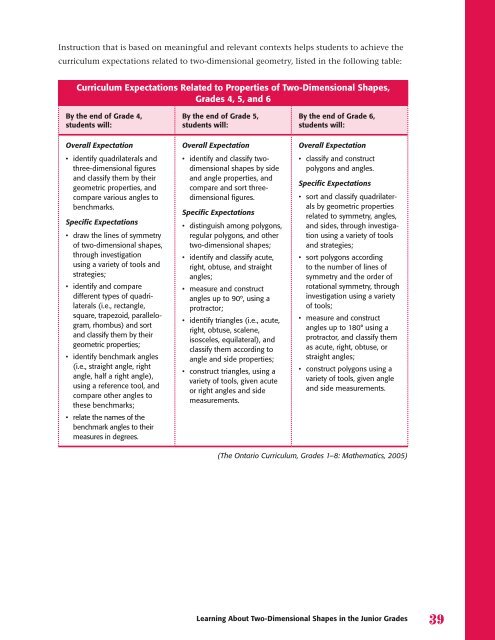Geometry and Spatial Sense, Grades 4 to 6 - EduGains
Geometry and Spatial Sense, Grades 4 to 6 - EduGains
Geometry and Spatial Sense, Grades 4 to 6 - EduGains
You also want an ePaper? Increase the reach of your titles
YUMPU automatically turns print PDFs into web optimized ePapers that Google loves.
Instruction that is based on meaningful <strong>and</strong> relevant contexts helps students <strong>to</strong> achieve the<br />
curriculum expectations related <strong>to</strong> two-dimensional geometry, listed in the following table:<br />
Curriculum Expectations Related <strong>to</strong> Properties of Two-Dimensional Shapes,<br />
<strong>Grades</strong> 4, 5, <strong>and</strong> 6<br />
By the end of Grade 4,<br />
students will:<br />
Overall Expectation<br />
• identify quadrilaterals <strong>and</strong><br />
three-dimensional figures<br />
<strong>and</strong> classify them by their<br />
geometric properties, <strong>and</strong><br />
compare various angles <strong>to</strong><br />
benchmarks.<br />
Specific Expectations<br />
• draw the lines of symmetry<br />
of two-dimensional shapes,<br />
through investigation<br />
using a variety of <strong>to</strong>ols <strong>and</strong><br />
strategies;<br />
• identify <strong>and</strong> compare<br />
different types of quadrilaterals<br />
(i.e., rectangle,<br />
square, trapezoid, parallelogram,<br />
rhombus) <strong>and</strong> sort<br />
<strong>and</strong> classify them by their<br />
geometric properties;<br />
• identify benchmark angles<br />
(i.e., straight angle, right<br />
angle, half a right angle),<br />
using a reference <strong>to</strong>ol, <strong>and</strong><br />
compare other angles <strong>to</strong><br />
these benchmarks;<br />
• relate the names of the<br />
benchmark angles <strong>to</strong> their<br />
measures in degrees.<br />
By the end of Grade 5,<br />
students will:<br />
Overall Expectation<br />
• identify <strong>and</strong> classify twodimensional<br />
shapes by side<br />
<strong>and</strong> angle properties, <strong>and</strong><br />
compare <strong>and</strong> sort threedimensional<br />
figures.<br />
Specific Expectations<br />
• distinguish among polygons,<br />
regular polygons, <strong>and</strong> other<br />
two-dimensional shapes;<br />
• identify <strong>and</strong> classify acute,<br />
right, obtuse, <strong>and</strong> straight<br />
angles;<br />
• measure <strong>and</strong> construct<br />
angles up <strong>to</strong> 90º, using a<br />
protrac<strong>to</strong>r;<br />
• identify triangles (i.e., acute,<br />
right, obtuse, scalene,<br />
isosceles, equilateral), <strong>and</strong><br />
classify them according <strong>to</strong><br />
angle <strong>and</strong> side properties;<br />
• construct triangles, using a<br />
variety of <strong>to</strong>ols, given acute<br />
or right angles <strong>and</strong> side<br />
measurements.<br />
By the end of Grade 6,<br />
students will:<br />
Overall Expectation<br />
• classify <strong>and</strong> construct<br />
polygons <strong>and</strong> angles.<br />
Specific Expectations<br />
• sort <strong>and</strong> classify quadrilaterals<br />
by geometric properties<br />
related <strong>to</strong> symmetry, angles,<br />
<strong>and</strong> sides, through investigation<br />
using a variety of <strong>to</strong>ols<br />
<strong>and</strong> strategies;<br />
• sort polygons according<br />
<strong>to</strong> the number of lines of<br />
symmetry <strong>and</strong> the order of<br />
rotational symmetry, through<br />
investigation using a variety<br />
of <strong>to</strong>ols;<br />
• measure <strong>and</strong> construct<br />
angles up <strong>to</strong> 180° using a<br />
protrac<strong>to</strong>r, <strong>and</strong> classify them<br />
as acute, right, obtuse, or<br />
straight angles;<br />
• construct polygons using a<br />
variety of <strong>to</strong>ols, given angle<br />
<strong>and</strong> side measurements.<br />
(The Ontario Curriculum, <strong>Grades</strong> 1–8: Mathematics, 2005)<br />
Learning About Two-Dimensional Shapes in the Junior <strong>Grades</strong>

















